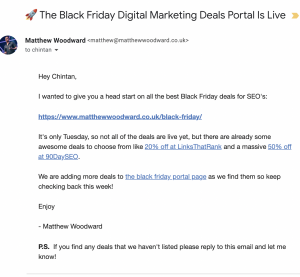The ultimate cover letter checklist
Follow these steps—plus check out our tips and examples—to help your cover letter stand out.
BY Gwen Moran
Resumes and LinkedIn profiles may get the lion’s share of attention, but a good cover letter can go a long way toward impressing hiring decision-makers. One survey by ResumeLab found that 83% of respondents claimed that a great cover letter can land an interview even if your résumé isn’t good enough.
But writing a cover letter is hard. Many applicants would skip them if they could. You may not know how to start, or the idea of writing about yourself might overwhelm you. And yes, the type of writing necessary for a cover letter is different from most other kinds of writing.
The good news? We’ve got you covered. Read on for easy steps you can follow to simplify the cover letter process, an example cover letter, and bonus cover letter tips.
What is a cover letter?
A cover letter is a note that accompanies a job application and/or resume that serves to introduce you to the employer and show why you’re a match for the job. You might think a resume does this just fine, but there are things a cover letter can do that a resume can’t.
“When you write a cover letter, the goal is to connect and find a common link,” says Angela Aylward, resume expert and tutor with Varsity Tutors. “A resume is an overview of your job history and skills, while the cover letter brings in your personality.”
In addition to explicitly connecting your skills and experiences to the job, your cover letter is also the opportunity to bring your resume to life with additional information. Overlook it and you’re missing a chance to stand out among the other candidates.
How to write a cover letter
Writing a cover letter can be overwhelming, but we’ve broken it down into easy steps:
1. Use the correct cover letter formatting
A cover letter is a formal business document, and it should look like one, says Aylward. In the upper left corner of your page, put the name, email address, company, and possibly the address of the contact, and include your own heading information as well like you did on your resume.
“I recommend that you match the format and font to your resume,” says Aylward. “A cover letter and resume should be a matched set, with organization and consistency.”
If the job application instructions ask you to put your cover letter in the text of an email, you can include your contact information in your email signature instead.
Additionally, choose fonts that can be easily read, Aylward adds. “You want to personalize the resume and cover letter but fun fonts can be difficult to read and look unprofessional,” she says.
As for structure, career coach Rachel Montañez typically recommends a compelling lead paragraph, then two to three short paragraphs or bullet points in the body highlighting your key strengths, and a closing that includes your interest in the next steps.
2. Don’t use an overly formal or generic greeting or salutation
When possible, it’s best to address your cover letter to a person instead of a generic option like “To whom it may concern,” says career coach Ronald J. Auerbach, author of Think Like an Interviewer: Your Job Hunting Guide to Success. However, if you’re responding to an ad, you may need to dig deeper. Alyward says, “This can be a challenge these days since a good portion of jobs are posted on sites that don’t mention the name of the person who is hiring…But not going the extra step to find and mention the name of a person is one thing that people miss.”
You can check LinkedIn to try and figure out the name of the hiring manager, career coach Merryn Roberts-Huntley, owner of Made To Hire says. “Ideally, it should be addressed to the actual person who is hiring for the position. If you can’t find the name of the hiring manager with confidence, then address the cover letter to ‘Dear Hiring Manager.’”
You can also address the letter to the team or department you would be joining. But always steer clear of “To whom it may concern.”
And be sure not to veer into overly formal territory. Hari Kolam, CEO of the talent acquisition platform Findem, told Fast Company in a previous report that it’s a delicate balance. “All too often applicants err on the side of formality, and it actually backfires.” Although “Hey,” is not appropriate, “Dear Sir or Madam” will sound too quaint. “Avoid overly formal language and long, complicated sentences that may disinterest the reader,” he said.
3. Start with a strong opening
You have just a few seconds to grab the reader’s attention, so start with whatever it is about you that will grab their interest, says Amy Soricelli, vice president of career services at Berkeley College. If you’ve been referred by someone influential, lead with that. Otherwise, think about the fact or brief anecdote that will catch interest. It might be your experience, expertise, or a big impact you made, Scoricelli says.
Whatever you do, don’t start your letter with an old chestnut like “I’m writing to express my interest in x position.” After all, applying to the right listing or making your purpose obvious in your subject line should already be established.
Sara McCord, formerly of The Muse, agrees. When she is reviewing letters for others, if the first line reads something like”I am writing to apply for [job] at [company],” she says she will delete it and suggest a swap every time. “When a hiring manager sees that, she won’t think, ‘How thoughtful of the applicant to remind me what I’m reading!’” she wrote. “Her reaction will be much closer to, ‘boring,’ ‘meh,’ or even ‘next!’” Think about using a statement like one of these:
- I’ve wanted to work in education ever since my third-grade teacher, Ms. Dorchester, helped me discover a love of reading.
- My approach to management is simple: I strive to be the kind of leader I’d want to work for.
- In my three years at [prior company], I increased our average quarterly sales by [percentage].
Such examples make you want to keep reading. That’s half the battle right there, McCord wrote. Additionally, she noted, it makes you memorable, which will help when you’re competing against a sea of applicants.
4. Make a clear connection between you and the company
Find and make a connection to something the company is doing, said Aylward. If you were referred by someone in your network, mention it immediately. Otherwise, do some research on the company and find something to connect to.
“Immediately saying what about the company drew you to their job post helps create a connection with the hiring manager,” she said. “Do a Google search, visit a company’s career page, or pull up things from Forbes or news agencies that give insight into the kinds of things a company is doing and being talked about.”
5. Use your body paragraphs to make your case
Now it’s time to move onto the body of your cover letter. “The bulk of the cover letter, which in its entirety should be about half a page, should be about your competencies and any results you can share that would help sell you for the position,” Roberts-Huntley says.
Study the job description before deciding what to include. “Highlight your biggest achievements that fit the role,” says Aylward. “Take a close look at the job keywords or jargon. Your cover letter should be tailored to the job and not a repetition and copy-and-paste of your resume.”
Make a powerful case for why you’re the right person for the job and company, Montañez says. Use active words to describe how you truly made a difference. Instead of “I have worked on financial reports,” try “I single-handedly created my team’s financial reports and presented them to senior management.” Bring a sense of enthusiasm to the writing, she advises.
Many candidates (especially those starting their careers) make the mistake of focusing too much on how the job will benefit them, rather than how they can benefit the company. One of the best ways to show your value to the company is to understand their pain points and troubles, and then identify how you, as a candidate, can help them. Beyond reading the news, you can try to organize informational interviews with people in the company (who aren’t your hiring manager) to find out more about their issues.
When you’re not an insider, however, it’s easy to misidentify a company’s problems. If you can’t get the employees to share the issues they’re facing, talk about your previous successes. Recruiter and professional résumé writer Donna Svei called this an “opportunity letter.” Svei suggested writing about a time that you over-delivered on a project and based on those experiences, how you’d bring that level of excellence to the role you’re seeking.
6. Close strong
Just as the right salutation sets the tone for your letter, a strong close can help you end on the right note. Close the letter reiterating your interest in the position, Roberts-Huntley said.
“Say something along the lines of, ‘I hope to have the opportunity to make a positive impact on your business and the team,’” she suggested. “Adjust it to make sense for the position but create a positive statement about what you’ll do or bring to the position if given the chance.”
Example cover letters
Here are example cover letters that follow the steps above:
Cover letter example #1
This sample cover letter is for an entry-level candidate coming out of college:
Dear Toni,
I was always one of those kids who spent all their time outside. I was lucky enough to grow up near the woods and just a short drive from Allegheny National Forest. I couldn’t get enough of all the plants and wildlife, and that’s why when it came time to choose a college major, ecology and conservation was a no-brainer. I’ve spent the last four years in college learning about field work and experimental techniques and my whole life loving the Allegheny National Forest, and I’d love to help preserve it as your next Jr. Ecology Assistant.
The job description noted that you’re looking for someone to manage the soil sample collection and testing for the team. I’ve spent the last two summers doing field work as part of my internships. I’ve focused extensively on soil sampling and presented my findings at several conferences in both poster sessions and as one of three undergrad speakers at the 2024 EPA Forestry Conference earlier this month.
You’re looking for someone with experience in a lab environment, and I’m currently an undergraduate lab technician for Dr. Woodsman’s ecology lab at the University of Pennsylvania. I assist my PI, two post grads, and five graduate students with supply management, experiment and solvent preparation, and equipment scheduling. I also developed a new system for tracking supplies so that I can order more before anyone’s research is disrupted.
I would love to bring this experience to Allegheny Ecology Group after I graduate this May. I look forward to hearing from you about next steps.
Sincerely,
Kayla Green
Cover letter example #2
Here is a sample cover letter for someone looking to make the next step in their career:
Dear Olivia,
I’ve been a fan of ZGames ever since you launched Moonlake Hills in 2015. My first experience in professional social media was actually a Moonlake YouTube channel where my friends and I would compete in different fan challenges. I’ve continued to play all of your games as I started my marketing career and seeing your job posting for a Social Media Manager felt like the stars (or moons) had aligned.
For the last two years I’ve been a Digital Marketing Coordinator at Playdom where I helped grow our social media following from 100k across all channels to nearly 500k. The job listing mentioned that ZGames is looking to start up a TikTok channel: I produced and directed Playdom’s first series of TikTok videos, which netted over 1 million views. I believe I could do even better with my deep knowledge of your games and your fanbase.
I’ve also followed ZGames’ socials since the beginning, and I’m well versed in the brand’s voice and posting style. I’ve done copywriting for social posts and ads on YouTube, X (Twitter), Facebook, TikTok, and Instagram, so I’m no stranger to this part of the job either. Additionally, I’m currently in charge of pulling and reporting data to the marketing team for all of Playdom’s social media and newsletter efforts.
I’d love to bring my extensive experience in social media marketing and ZGames’ catalog to your company. Thank you so much for considering my application.
Sincerely,
Joseph Honeydew

Cover letter tips
Here are some bonus pointers to help you as you write your cover letter.
1. Write with the job description in mind
Your cover letter, like your resume, should be tailored to the job description rather than falling into the trap of pitching to the company in general. As Dan Geiger, Buzzfeed’s former senior manager of people operations, previously told Fast Company, a lot of entry-level hires spent their time sharing their thoughts about how great Buzzfeed is. According to Geiger, it’s better to show your enthusiasm “for the specifics of the role,” rather than the organization. After all, if you just wrote your cover letter with the company in mind, you’re making the recruiter and hiring manager do all the work. By tailoring your pitch to the role, you can sell yourself more effectively.
2. Focus on what you can bring to the company
Let recruiters and hiring managers know exactly how you’re of value. Pick out the most important skills, experiences, training, accolades, and other accomplishments, says career coach Ronald J. Auerbach, author of Think Like an Interviewer: Your Job Hunting Guide to Success. Share them in descending order of importance.
McCord adds, “Even if you’re applying to your dream company, you don’t want to come off like you think someone entertaining your candidacy is the same as him offering you water at the end of a lengthy hike. You don’t need to thank the hiring manager so incredibly much for reading your application–that’s [their] job.”
So skip the effusive thanks and demonstrate genuine interest by writing a cover letter that connects the dots between your experience and the requirements of the position. Telling the reader what you’ve accomplished and how it directly translates to meeting the company’s needs is always a better use of space than gushing.
3. Get the tone right
“Aim to make the letter friendly, clear, and professional.” Kolam says, “A good best practice is to research the company’s brand and tailor the wording in a way that speaks their language.” For example, if you’re applying to a very traditional company like an established law or accounting firm, you’ll likely want to stick to more formal language. On the other hand, a cover letter to a tech startup can likely be more relaxed (but still professional) in tone.
4. Show, don’t tell
Your cover letter is an opportunity to give the person reading it a brief glimpse into who you are as a person, Soricelli says. And stories often do that better than a list of job duties you’ve performed.
McCord explains that if you write a laundry list of your skills, your cover letter will blend into every other submission formatted the same way. The goal isn’t just to show you’re qualified; it’s to make the case that you’re more qualified than all the other applicants. You want to make clear what distinguishes you, so the hiring manager can see why you’re worth following up with to learn more. You want to be memorable. So, break up those skills recaps with anecdotes or splashes of personality.
This is a real, two-line excerpt from a cover letter she wrote:
“If I’m in a conference room and the video isn’t working, I’m not the sort to simply call IT and wait. I’ll also (gracefully) crawl under the table, and check that everything is properly plugged in.”
A couple of lines like this will not only lighten up your letter but also highlight your soft skills. This introduction illustrated that she is a take-charge problem solver, without saying, “I’m a take-charge problem solver.”
Plus, the “(gracefully)” reference shows that she has a sense of humor and doesn’t take herself too seriously–even in a job application. If your submission follows the same list-type format all the way through, see if you can’t pepper in an example or anecdote that’ll add some personality.
5. Keep it short
Many companies now use applicant tracking systems, which can typically accommodate a cover letter of up to 250 words, Montañez says. “There has been some research done that shows that the length that typically gets past an applicant tracking system,” she said.
According to another ResumeLab survey, 82% of experts reported that the ideal cover letter length is about a single page, and while others said less than half a page is preferred. Aylward says, “Recruiters are looking at 200 to 300 applications for each position. Give them all of the information they need quickly and you’ll stand out.”
6. Avoid cliches
Scan for clichés and remove them, Aylward says. “For example, everyone says, ‘I’m very excited to see your job posting,’” she advises. “Your letter should reflect your personality without being over the top. Be creative with your language, but don’t make it look like you walked through a thesaurus.”
Aylward continues, “Everyone says they’re a hard worker or creative problem solver. Instead, you could say, ‘I solved this particular problem when I worked at this company and was able to reduce their end-of-month open invoices down by 90%.’ Use statistics and specific examples instead of clichés.”
7. Proofread carefully
Once you’ve got the cover letter drafted and polished, it’s critical to spend some time proofreading, Soricelli says. McCord wrote that typos and mistakes caused her to toss some résumés. Typos can indicate carelessness and put you out of the running before you start. Here are some ways to make sure your résumé is error free:
- Use your word processing program’s spell check and editing functions.
- Find a professional proofreader—or even just a friend who’s good at proofing—to review your letter.
- Try the old “writer trick” of reading each word and sentence from the end to the beginning. This can help you disrupt the flow of the writing and more easily spot mistakes.
It’s common advice, but cannot be overstated, Soricelli says. The reason career experts keep telling people to proofread is because the advice is often ignored. Typos can indicate carelessness and put you out of the running before you start.
Stephanie Vozza and Regina Borsellino also contributed writing, reporting, and/or advice to this article.
ABOUT THE AUTHOR
(14)







